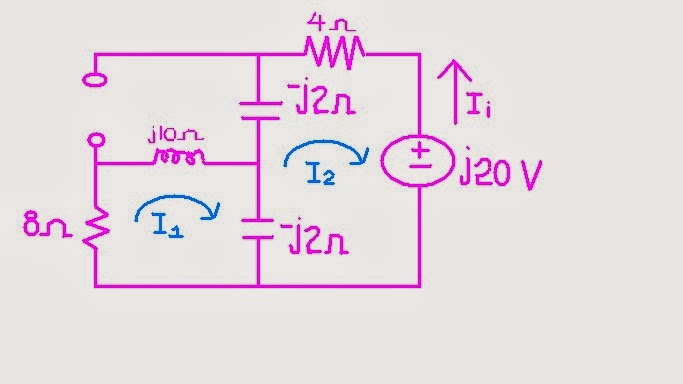In our previous discussion we learned that the forced steady-state response of circuits to sinusoidal inputs can be obtain by using phasor where this phasor is in complex form. In this section we will discuss about in the superposition theorem in the form of phasors in knowing current and voltages.
The
principle of superposition states that the response (a desired current or
voltage) in a linear circuit having more than one independent source can be
obtained by adding the responses caused by the separate independent sources
acting alone.
The superposition
theorem gives a method for finding the currents in the circuit which then
enables all the voltage drops to be calculated. The procedure is described
below:
-Redraw the circuit for each e.m.f. in turn shorting out the
other e.m.f
-Calculate the currents that would flow due to each e.m.f.
acting alone
-Finally add the branch currents from each of the circuits
(taking into account their direction*) to find the branch currents for the
original circuit
-Use these currents to find the voltage drops in the original
circuit
Example problem:
Using super position we have to kill sources across the circuit and leave one voltage source. We have two sources. This means that we have two circuits. We have to solve each of its current at the same branch.
Killing the current source
Remember that we should leave voltage source, current must be set to zero and the path leaved open.
In the circuit we can now perform the series-parallel to make it
simpler.
8 Ω * j10 Ω
(* means series)
Z1 = 8 Ω + j10 Ω
Z1 // -j2 ( below capacitor)
// means parallel
Z2 = (8 + j10 )(-j2) / (8 + j10 )
+ (-j2)
Z2 = 1/4 - j 9/4
Z2 * -j2 (above capacitor)
Z3 = (1/4 - j 9/4) + -j2
Z3 = 1/4 - j 17/4
=tis illustration is the a branch contains a multiple of impedance came from different branches after simplifying the circuit.
This circuit we are looking for current of 4Ω so we will use
KVL.
(1/4 - j 17/4) I + 4 I = -j20
((1/4 - j 17/4) + 4 ) I = -j20
I = 2.353 - j2.353
Since I = -I1 (negative because
of the opposite directions of currents)
I1 = - 2.353 + j2.353 A
I1 = 3.33 ∠ 135 A
(first current)
Killing the voltage source
We have
to remember that, it is important to leave the branch that has the required
unknown value at ease so that we can easily get its value. (I am talking about
the 4 Ω resistor)
In this circuit we can use mesh analysis for better
calculations.
I3 = 5 A --------> equation 1
@ mesh 1
8 I1 + j10 I3 - j10 I3 - j2 I1 + j2 I2 = 0
Since we already have I3, substitute this equation @ mesh 1
I1 (8+j8) + j2 I2 = 50i ---------> equation 2
@mesh 2
-j2 I2 + - j2 I1 - j2 I2 + j2 I3 + 4 I2 =0
I2 (4-4j) + j2 I1 = -j10 --------> equation 3
Using matrix,
(8+j8) j2
= 50i
j2 (4-4j)
= -j10
Δ2 = (8+j8)(4-4j) + ( j2 )( j2 )
Δ = 68
We will only solve the I2 in the equation. We don't need I1.
Δ2 = (8+j8)(-j10 ) - (50i)(j2 )
Δ2 = 180 - j80
So,
I2= (Δ2 / Δ)
= (180 - j80) / 68
= 2.90 ∠ -23.96 A (second current)
Our first current is 3.33 ∠ 135 A and second current is 2.90 ∠ -23.96 A. To get the actual value of the required
parameter we will add up the two current.
Yields,
Total current I = 3.33 ∠ 135
+ 2.90 ∠ -23.96
I = 6.116∠144.978 A
_____________________________________________
* Note to add the branch currents while taking into account
their direction may actually require one current to be subtracted from another.
If both currents are flowing in the same direction you simply add them, but if
the currents are flowing in opposite directions you subtract the smaller
current from the larger one. The resultant current will flow in the same
direction as the larger current.
I've learned that in super position theorem can be apply to AC
circuits. And its application is the same way to DC circuits. The difference
is, it uses complex number in AC circuit. I learned that this theorem is very
useful when the sources are in different frequencies.
I also learned that since source are in different frequencies
the impedance must be solved in separate but the same circuit and contains one
source (the rest must be set to zero or kill) it is because impedance depends
on frequency. With this, each circuit must produce required values of the
required parameter.





